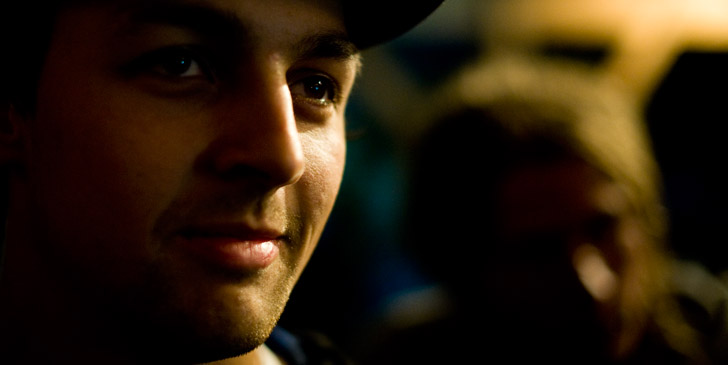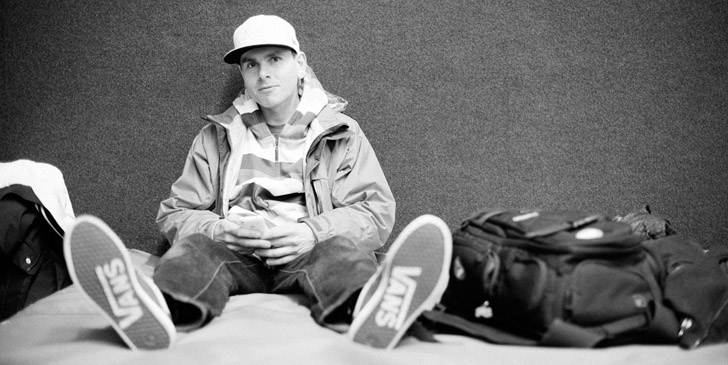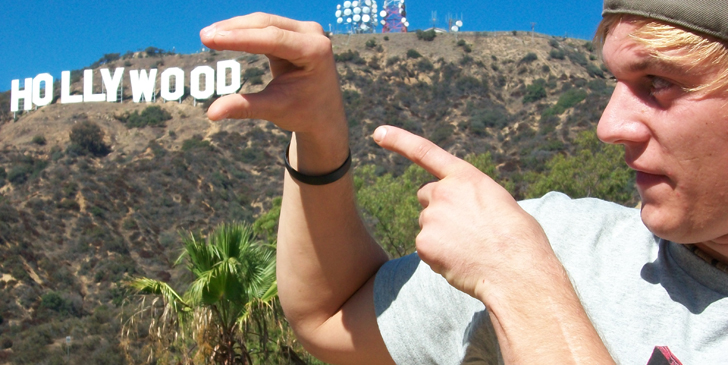
“Even if there are a lot of rider owned companies today, there is still a lot of ’80-s or early ’90-s mentality”
“Even if there are a lot of rider owned companies today, there is still a lot of ’80-s or early ’90-s mentality”
How did you get involved with BMX?
Well, I grew up in Alaska and being up there in the snow and the winter and stuff, even when I was 8 years old my dad got me into motorcycle racing, he wanted me to be a motorcycle racer but I would come home from the motorcycle track and I just put my motorcycle away and ride my bike and I never even cared about motorcycles, I wanted to ride my bicycle.
What year was that?
That was like in 1978-’79. It’s strange because it’s opposite to most kids, they ride a bicycle but they want a motorcycle. I never cared about motorcycles. It’s even funny because in 1980 when I was 10 or 11 years old, just from riding bicycles all the time, I would jump, I had a Yamaha YZ 80 and I could do no-footers, no-handers and cancans and I could do fastplants on motorcycles, like Voelker plants when I was 11. All that freestyle motocross stuff that these guys are doing now I did when I was 11 years old. I traded my YZ 80 for a complete Kuwahara race bike.
I had always seen California in the magazines and I would be practicing flatland all winter in my garage doing Miami hoppers and cherry pickers and when summer would come I had ramps in my yard and I would ride all the time. We actually had a really good scene, especially for that time but I was born for California and not for Alaska, that’s for sure. My last year at high school when I was 16 I got to move to San Diego and within 6 months of living there that’s when they had that first street contest and I got first place in expert. Then I got in all the magazines right there and I got sponsored. RL Osborn, everybody’s hero at the time, came up to me in his Porsche after the contest and he rolls up and said: “Hey, how would you like to ride for Hammer?” and I was like; “What?” I was so stoked because it was some kind of superstar thing with his Porsche, you know Mr. Cool. Then I got hooked up with Vision Street Wear so I was getting sponsors and stuff and the next contest I entered was only 4 or 5 months later, not even that long and I got 5th place in Pro. That’s basically where I got in the magazines and the retarded scene of BMX.
How did you experience the change form AFA quarterpipe-contests to Meet The Street contests and halfpipe contests. Was it time for a change?
It was definitely time because everyone was bored with the quarterpipe contests. Skateboarding always pushes bikes for some reason because of the age group I guess. We pay attention to what skateboarders are doing and it influences us I guess. At that time I was skateboarding a lot and I was doing wallrides and a lot of fast plants on skateboards and I hung out with a lot of pro skater guys and I just got on my bike and applied that stuff instantly to bike riding. Eddie Roman was one of the first people I met in California and he just blew my mind. Seeing only the magazines I didn’t know that street had already progressed that much. I’d see Eddie Roman and he would do 540-s off of launch ramps and stuff, just big and onto flat, it blew my mind, and wall rides. I knew that this was definitely what I was all about. I would just go out all night. It’s interesting. Like now I don’t have that much time to go riding by myself but all the tricks that I invented in street like tailwhip footplants and fakie wallrides and all the no-footed footplants and stuff was all done riding by myself. I would go out at night. I knew bikes were going to go in that direction and I was excited about it, I was stoked. Bike riding has progressed to this day in a way that I am super excited about, the industry still is at least 5 years behind itself. We should be so much farther along as far as the company owners and as far as people putting their trust in investing their time and money into BMX, into street riding. I think that people don’t put enough faith in our sport. It is going to change, it is the best extreme sport. It’s the best to watch on TV, it’s the best to do, you can ride on dirt, on pavement, on wood, on cement a little puddle doesn’t stop you. It costs a lot to get into but no pay no gain.
You and your crew with Kaarlo Wik, Ronnie Farmer, Brad Blanchard and Jimmy Arlington were on Bully and Hammer for a while. What made you decide to change?
I thought that Bully with RL was going to be the beginning of that, people putting faith in street, but RL still had that eighties mentality. He had a little bit of vision but not enough for me. He sent me a letter at the time explaining to me what kind of T-shirt I needed to wear and what color of pants I needed to wear for a photo shoot and I would go to a contest and he hands me a pack of clothes and tells me to put it on and I was not down with that. We were doing that video, the Bully Slowride video which is the “greatest” video ever made and I spray painted my Bully mat black and I put DirtBros stickers on it and RL showed up at the trails and he looked at it and said: “What did you do to the bike?” and I was all: “It’s DirtBros, it’s cool!” He was all mad and I was all “It’s hardcore, it’s cool”. His bikes were always shiny and had neato stickers on it so he was all angry seeing the mat black bike. It was the straw that broke the camel’s back seeing his true motivations for marketing. It’s not bad to use people for marketing because that’s what sponsorships are all about but he had a different vision of what I thought the direction would be where bike riding was going. RL had ran some full page ads with us and set the name DirtBros and I just figured that why not use his money in advertising for our own good. that’s when I started DirtBrothers and bought the frames and put DirtBros stickers on them and we ran an ad in the magazine and picked up a lot of riders like Brian Blyther who ran our stickers and was down with our video and stuff, Eddie Roman was riding our bike and we had serious riders on our team and everyone was supportive of it because that was the beginning of what people actually wanted. The riders wanted to have control of the sport. I was just making a statement. I wasn’t doing it to make any money. I was out to say, if you put faith in bikes, it will work, you just have to have the faith to put your money out there and at the time I didn’t have much money. It cost me like $ 5,000.= USD which is a lot of money, I was like 20 years old at the time and BMX was pretty dead. I spent a lot of money, 5 grand in one shot to do it and it fully worked.
The way I did it where people really took notice was when anybody of the magazines would ask me how many frames I sold I would say: “We’re doing REAL good” so the facade, world wide people would think we were selling a ton of stuff and we got tons of pictures in the magazines and all in reality we only sold 50 frames but to the world it seemed like we sold 50.000 frames. Even today, 15 years later I still have people come up to me saying that they have their first DirtBros frame. I still have one, they were good frames, they were made in America, they were awesome bikes. It was just a statement, it wasn’t to make any money and that’s why we got out of it. Three years went by and I just got frustrated with the industry that they weren’t seeing the potential and I just wanted to ride for fun and didn’t want to deal with it any more. I do care about bikes and the industry wasn’t and that frustrated me. That’s why we’re back into it again with DirtBros, I want to make a difference and stick with it until we do something.
What’s the situation right now? What made you decided to come back?
Alliant made some of our bikes at first, then Solid built them but it just took too long for them to get us frames so we got into it a year ago. We can make 200 frames a month now ourselves and we don’t have to wait any more. It took us 6 months to get 100 bikes before. Solid did a little bit better job but we just needed to be in control and now we can have like 5 different models fairly easy. The reason why we got back into it was that me and my partner Jim Sibley, we were working across the street from this machine shop that made bike parts and we’d say hey, let’s make some DirtBros sprockets and as soon as I made them the response was huge. People were down for it.
Do you think it was old guys being stoked to see the name again or also younger riders?
I think it was old guys but also kids that heard so much about DirtBros but they didn’t know what it was so they were interested in it. But also, we’ve always been in San Diego, we already had some huge support in San Diego. In my opinion Gary Young is out of San Diego, Chris Meyers, we got some much talented kids there. Mike Parenti, another amazing kid. They were all down for DirtBros right off the bat. It just grew.
Even if there are a lot of rider owned companies today, there is still a lot of ’80-s or early ’90-s mentality. We still need to move in the marketing aspect. It’s hard for us because we don’t have any money but the rider still needs to be the one that is pushed and supported because without the riders there is nothing. Now you have all these companies that have awesome parts but still it’s all about the rider. If you have Van Homan on your team you’ll sell bikes. It’s proven. Tiger Woods is sponsored by Nike, Michael Jordan-Gatorade. It’s proven in every industry that people that support the riders are companies that sell the product and we still haven’t got there. We still have some ways to go.
Would you be into getting sponsored by Mountain Dew or Oakley for instance?
Oakley is a good example. Selling out has more to do with letting go of control of your life. Mike Vallely, he’s a hardcore skateboarder, he rides for Oakley and he has taken control of the advertising that they do with him. I don’t see a problem in having a big company support you in what you do and what you stand for as long as you have control of it. I think selling out has more to do with signing your life away and letting them take your name and your image and let them do whatever they want with it. I think that’s where we have gone wrong. Some riders in our sport are awesome bike riders and if marketed right and they could be used to make our sport grow but they’re scared of selling out. I think Rick Thorne has done a good job of keeping control of his marketing, he’s a genius marketer. Skateboarders, they all do it. Baker skateboards, people think they’re all hardcore but they’re ran by the same people who run Birdhouse. It’s all a marketing game and I think we’re behind. I think a lot of the hardcore guys that don’t want to sell out, they need to wake up and realize if they want our sport to grow. I’m right there too, I need to wake up more and realize if we want our sport to grow we need to latch on to people about money but at the same time keep control of our images and what we stand for.
What’s going on now compared to what was going on back then as far as riding is concerned?
Back then, on a daily basis almost, you could come up with a trick that nobody had ever done before. It was exciting. I could come home and be so stoked. I could do fakie wallrides to no-footers and cancans and nothing and know nobody has ever done that before. You had never seen it in a video. Learning a tailwhip footplant on a wall was big, no one had done it, it was brand new. I could go out all the time and come up with tricks that I had never seen before and I think a lot of people from back then were like that. That’s why Matt Hoffman is Mat Hoffman because he was going out every day and would come up with something that noone had done. And Eddie Roman, no one had done the stuff he did those days, and Voelker and flatlanding was progressing fast knowing nobody had done the trick before whereas now the kids do a lot of copying. You’ll see some really good kids that have no originality.They just copy what they see in the videos. Unique kids with originality stand out because there is about a million kids that can do tailwhips, a million kids that can do fufanus on rails, there’s a million kids that can do giant wall tabs, kickflips, they can all do it so it’s almost like I don’t even have the desire to do half that stuff because everybody does that. I think that’s the major difference. It’s harder to be original but you can still do it.
Could you be satisfied just cruising around not learning a new trick every session?
For me I like both. I love doing skids, I love jumping and do table tops and doing style stuff but still I love coming up with new stuff. On RoadFools I learnt that 540 tailtap powermower one-handed and I was pumped! There’s still so many tricks to learn. I still learn new stuff all the time and make some stuff up and I think it’s a matter of putting yourself in a mind set of what else can we do because we get stuck in a rut when we just practice the same tricks over and over that somebody else has already done. My favorite tricks are just tire slides and rolling backwards I have fun doing both but I’m real happy when I come home and learnt something that is new, that I haven’t seen anybody else do. I’m still stoked on that.
Last words:
Buy or die, D.B.I.
Text: Bart DeJong | fotos: Bart de Jong






Share